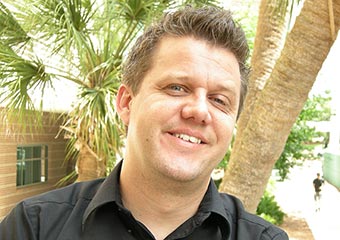Features
On the Brink of a Cure
| USF Health

Dennis Kyle
USF researchers played a key role in the discovery of a new antimalarial drug with the potential to simultaneously cure and block transmission of the mosquito-borne disease.
Roman Manetsch, associate professor of chemistry, and Dennis Kyle, professor of global health, were co-leaders of the USF team that helped to discover and develop a series of potent compounds, known as quinolones, to combat malaria.
The researchers narrowed the most effective drug candidates in the quinolones series to one lead candidate — ELQ-300.
The drug candidate, which appears to be effective at low doses, could likely be produced more cheaply than existing antimalarial drugs — a huge advantage in treating a tropical disease that kills nearly one million people a year. In addition, in repeated animal experiments, parasites did not develop resistance to ELQ-300, a major obstacle in drug development today.
“This is one of the first drugs ever to kill the malaria parasite in all three stages of its life cycle,” says Kyle, a member of the Global Infectious Diseases research team at the USF College of Public Health. “If the drug can break the parasite life cycle, we may ultimately eradicate the disease.”
The USF researchers were part of a larger Medicines for Malaria Venture (MMV) project team including & Health & Science University in Portland, Drexel University in Philadelphia and Monash University in Australia.

Roman Manetsch
The newly identified drug class was derived from the first antimalarial quinolone, endochin, discovered more than 60 years ago but never pursued because it appeared not to work in humans.
Using new technology to optimize the quinolones, the project team demonstrated that the compounds were indeed highly effective against the most lethal strain of malaria, as well as the parasite responsible for the majority of cases of malaria outside of Africa.
“It was a balancing act to optimize an antimalarial drug so that it was soluble and metabolically stable, without compromising its potency,” Manetsch says. “We wanted a compound that within an individual would not break down too quickly, remain circulating in the blood for a long enough period to kill the parasites, and be highly active in blocking transmission in rodent models of malaria.”
ELQ-300 targets a protein complex of the mitochondria, the energy household of a cell. Manetsch, with the help of Kyle’s expertise in parasitology, and the resources of the CDDI, structurally modified the quinolone scaffold so that the drug candidate would hit only the malaria parasite’s target while sparing the human mitochondria.
Now Kyle is working as a technical adviser to the MMV project team preparing the new drug candidate for clinical trials. If approved, ELQ-300 could mean the beginning of the end for a disease that is among the leading causes of illness and death worldwide.